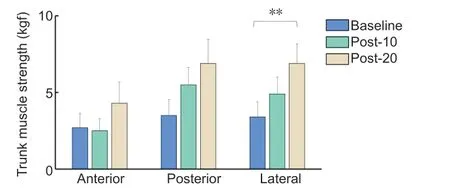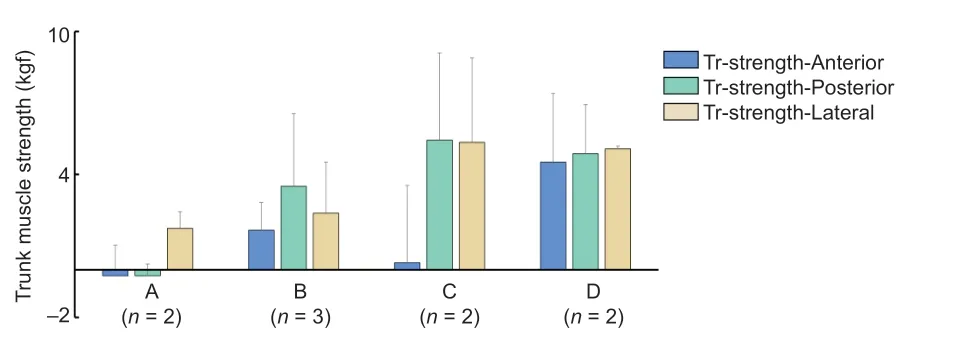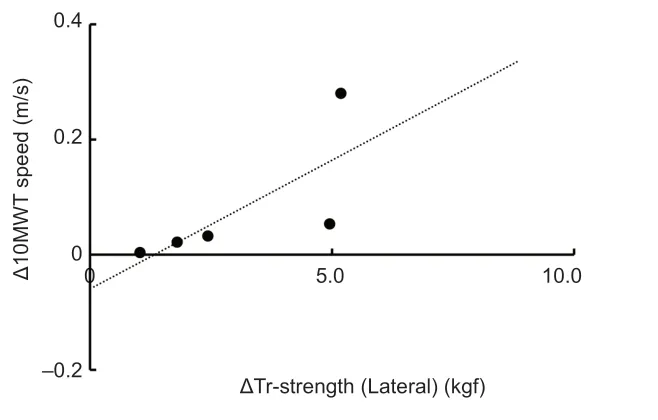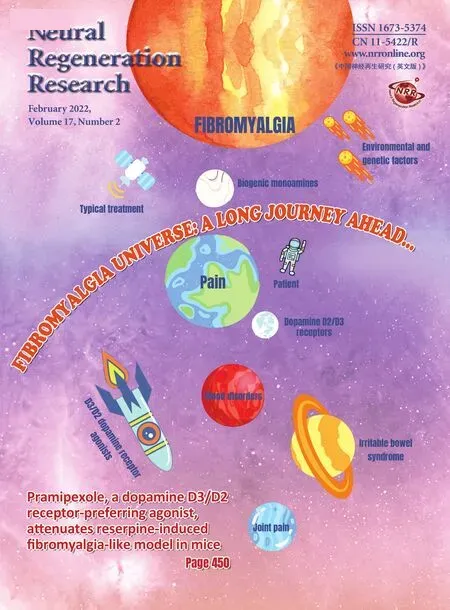Neurorehabilitation using a voluntary driven exoskeletal robot improves trunk function in patients with chronic spinal cord injury: a single-arm study
Hiroki Okawara,Syoichi Tashiro,Tomonori Sawada,Keiko Sugai,Kohei Matsubayashi,Michiyuki Kawakami,Satoshi Nori,Osahiko Tsuji,Narihito Nagoshi,Morio Matsumoto,Masaya Nakamura,
Abstract Body weight-supported treadmill training with the voluntary driven exoskeleton (VDE-BWSTT) has been shown to improve the gait function of patients with chronic spinal cord injury. However,little is known whether VDE-BWSTT can effectively improve the trunk function of patients with chronic spinal cord injury. In this open-label,single-arm study,nine patients with chronic spinal cord injury at the cervical or thoracic level (six males and three females,aged 37.8 ± 15.6 years,and time since injury 51.1 ± 31.8 months) who underwent outpatient VDE-BWSTT training program at Keio University Hospital,Japan from September 2017 to March 2019 were included. All patients underwent twenty 60-minute gait training sessions using VDE. Trunk muscular strength,i.e.,the maximum force against which patient could maintain a sitting posture without any support,was evaluated in four directions: anterior,posterior,and lateral (right and left) after 10 and 20 training sessions. After intervention,lateral muscular strength significantly improved. In addition,a significant positive correlation was detected between the change in lateral trunk muscular strength after 20 training sessions relative to baseline and gait speed. The change in trunk muscular strength after 20 training sessions relative to baseline was greatly correlated with patient age. This suggests that older adult patients with chronic spinal cord injury achieved a greater improvement in trunk muscle strength following VDE-BWSTT. All these findings suggest that VDE-BWSTT can improve the trunk function of patients with chronic spinal cord injury and the effect might be greater in older adult patients. The study was approved by the Keio University of Medicine Ethics Committee (IRB No. 20150355-3) on September 26,2017.
Key Words: body weight-supported treadmill training; gait disorders; hybrid assistive limb; neurologic; neurophysiotherapy; postural balance; precision medicine; robot-assisted gait training; robotics; spinal cord injury; trunk
Introduction
Most patients who experience spinal cord injury (SCI) achieve recovery of motor function (Fawcett et al.,2007). Although improvements in acute treatment have reduced mortality rates following SCI (Strauss et al.,2006),many SCI survivors experience severe chronic sequelae. While a number of animal studies have investigated the molecular mechanism of neural regeneration,it is important to delineate the phenotype in clinical studies (Brown and Martinez,2019; Filipp et al.,2019). There is strong evidence that SCI can be improved by various types of locomotion training (Donenberg et al.,2019; Yu et al.,2019; Zhang et al.,2019). Particularly,body weightsupported locomotion training and robot-assisted gait training (RAGT) have improved gait function during the chronic phase in patients who experience incomplete SCI (Lam et al.,2007; Esquenazi et al.,2012; Bach Baunsgaard et al.,2018; Loy and Bareyre,2019),as well as in post-stroke patients (Bruni et al.,2018). Voluntary driven exoskeletons (VDEs) have advantages over other rehabilitation robots in that assistive motion is triggered by a subject’s voluntary contractions (Grasmucke et al.,2017). VDE training is known to immediately improve parameters of lower limb kinematics (Matsuda et al.,2018) and muscle activity (Shimizu et al.,2017),to correct synergy control of the lower limb muscles during gait (Tan et al.,2018),and increase excitability in the primary somatosensory cortex (Sczesny-Kaiser et al.,2015). In addition,gait training on treadmill or overground using the combination of VDE with a body weight-supported device improves gait ability,even in the chronic phase (Sczesny-Kaiser et al.,2015; Grasmucke et al.,2017; Jansen et al.,2018). Taken together,these findings indicate that VDE can improve residual neural functions by activating impaired spinal cord pathways.
Although few VDEs are commercially available,hybrid assistive limbs (HALs,Cyberdyne Inc.,Ibaraki,Japan) of robot suits are attracting wide attention,as they can apply an electromyographical signal to trigger motion. HAL have been certified by the CE as a medical device in the European market,and gait training for SCI patients using HAL is covered by industrial accident compensation insurance in Germany (Matsuda et al.,2018). In addition,Japanese public health insurance recently started to cover HAL for rare progressive neuromuscular diseases,including HTLV-1 associated myelopathy,in which motor dysfunction is similar to that observed in SCI (Matsuda et al.,2018).
Despite technical progress,the functional prognosis of these patients is not favorable,especially for those with more severe impairment. It has been shown difficult to re-establish gait ability,even with RAGT,in SCI patients with poor lower limb strength (Yang et al.,2011; Yang and Musselman,2012; Piira et al.,2019). Although a few studies have shown that patients with chronic complete SCI can recover balance or trunk muscle activity (Bjerkefors et al.,2009; Sylos-Labini et al.,2014; Squair et al.,2016),no studies to date have investigated the effects of VDE neurorehabilitation on recovery. This study therefore assessed the effectiveness of body weightsupported treadmill training (BWSTT) with VDE (VDE-BWSTT) on trunk function in patients with chronic SCI.
Subjects and Methods
Study design
This open-label,single-arm study enrolled nine outpatients who received treatment in Keio University Hospital,Tokyo,Japan from September 2017 to March 2019. Participants were recruited individually,regardless of neural level and severity of injury. The sample size was calculated as nine according to a previous study describing trunk muscular strength changes after inpatient rehabilitation in patients with non-traumatic SCI (Gabison et al.,2014). Therefore,10 participants with chronic SCI were enrolled,with the expectancy that there would be exclusions or drop-outs. The study protocol was fully compliant with ethical guidelines for medical and health research involving human subjects,including theDeclaration of Helsinki,and was approved by the Ethics Committee of Keio University School of Medicine (IRB No. 20150355-3) on September 26,2017. Written informed consent was obtained from all study participants before enrollment. No insentive was given to the study participants. This study was registered in UMIN Clinical Trials Registry (UMIN-CTR; UMIN000021907) (https://www.umin.ac.jp/ctr/).
Study participants
Participants were included if they were aged 20-75 years,had self-reported disturbed motor function,and had achieved motor function recovery from paralysis symptoms. Subjects were excluded if they (1) had a disease or skin disorder that would make training impossible or be worsened by training,(2) had received interferon-alpha or botulinum toxin injections within the 6 months prior to enrollment,(3) had participated in another neurorehabilitation training program (such as other BWSTT or functional electrical stimulation) within the previous 3 months,(4) had undergone walking training with VDE within the previous 12 months,or (5) had any orthostatic hypotension that could impair VDE-BWSTT training or evaluation thereof.
Treadmill training with VDE
All participants underwent 20 VDE-BWSTT training sessions,at a rate of 2-5 sessions per week,as referenced to a previous report (Jansen et al.,2017) and investigator-initiated clinical research in Japan. HAL was used as VDE in this intervention study. Motion assistance was controlled by weak bio-electrical signals generated by active muscle contractions,which were captured by electrodes on the skin surface (Grasmucke et al.,2017). VDE training was performed on a treadmill with half of each individual’s body weight supported (excluding the weight of the VDE device) by a weight-supported device (PneuWeight,Pneumex,ID,USA),as described previously (Okawara et al.,2020). The velocity of the treadmill was set to each participant’s comfortable walking speed (0.5-2.5 km/h),with no incline within each session. The duration of each training session was 60 minutes,which included time to rest that did not exceed 20 minutes. All outcomes were measured at baseline and after 10 and 20 training sessions.
Trunk muscle strength
Trunk muscle strength was defined as the ability to maintain a seated posture in four directions (anterior,posterior,left lateral and right lateral) (Larson et al.,2010). Initially,participants sat on a table with their feet flat on the floor and their hips and knees at 90 degrees. Subjects were instructed to maintain an erect seated posture without back support,but were allowed to put their hands on the table next to them. An examiner placed a hand-held dynamometer (Mobie MT-100,Minato Medical Science Co.,Osaka,Japan) onto the participant’s body and measured the peak force while pushing the participant’s trunk perpendicularly until the participant could no longer maintain a seated posture (Figure 1). The force was applied at the mid-sternum to measure anterior trunk muscle strength,at the thoracic spine midway between the superior and inferior angles of the scapula to measure posterior trunk muscle strength,and at the left and right lateral aspects of the acromial process to measure right and left lateral trunk muscle strength,respectively. All measurements were taken by a single physical therapist,with another physical therapist engaged in support for safety measurements. All tests were performed three times after two practice trials,and the mean value of the three tests were applied to the assessments. Right and left lateral trunk muscle strengths were also averaged.
10 Meter walk test
Gait speed needed to walk 10 meters was assessed using the 10 meter walk test (10MWT) without VDE and with any aids if needed. These data were obtained from only five patients because of their severe paralysis and because they had been reported previously (Okawara et al.,2020).
Narrative statement
Participants’ subjective feelings about their body and activities of daily living (ADL) function were determined at the end of the intervention by an interviewer who did not otherwise participate in this study. The open-question was “Have you noticed any changes in your body or your daily life ?”.
Statistical analysis
Data were expressed as mean ± SD. Trunk muscle strengths in the nine subjects before and after 10 and 20 training sessions were compared by repeated-measures analysis of variance (ANOVA),followed by Tukey’spost hocmultiple comparison analysis test. Correlations between changes in trunk muscle strength and previously measured 10MWT speed (Okawara et al.,2020) were nonparametrically assessed using Spearman’s rank correlation coefficient,whereas correlations between changes in trunk muscle strength and subject age at baseline were parametrically assessed using Pearson’s correlation coefficient. AP-value < 0.05 was considered statistically significant. Data were analyzed using IBM SPSS statistics version 25.0 (IBM Japan,Tokyo,Japan).
Results
Characteristics of the study subjects
Of the 10 patients,nine patients with chronic SCI,consisting of six men and three women,aged 37.8 ± 15.6 years,and mean time from injury of 51.1 ± 31.8 months completed the study. One patient withdrew from the study because of his own convenience. Their baseline characteristics are shown inTable 1. None of the patients had a medical history other than spinal cord injury. Of the nine participants,three were categorized as having American Spinal Injury Association Impairment Scale (AIS) grade B and two each as AIS grades A,C,and D. The neurological level of injury was cervical in six participants and thoracic in three. All participants completed 20 training sessions with HAL. There were no adverse events. The subjective training intensity in Borg scale of each 20 training session is shown inAdditional Table 1.
Trunk muscle strengths
Trunk muscle strengths in three directions improved from baseline after 20 training sessions,although the ANOVA test showed that only lateral muscle strength improved significantly (F(2,16)= 8.90,P= 0.003,η2= 0.53),whereas anterior (F(1.21,9.72)= 2.86,P= 0.119,η2= 0.26) and posterior (F(2,16)= 3.56,P= 0.053,η2= 0.31) trunk muscle strengths did not (Figure 2).Post hoctests,however,showed significant improvements in lateral (from 3.4 ± 2.8 to 6.9 ± 3.6,P= 0.002) and posterior (from 3.5 ± 2.9 to 6.9 ± 4.4,P= 0.044) trunk muscle strengths after 20 training sessions relative to baseline.Figure 3shows changes in trunk muscle strengths after 20 training sessions relative to baseline in each AIS grade subgroup. Whereas anterior trunk muscle strength improved only in the AIS-D subgroup,and posterior trunk muscle strength improved in both the AIS-C and AIS-D subgroups. Individual data are shown inAdditional Table 2.
Correlation between the changes of 10MWT speed and trunk muscle strengths
Improvements in lateral trunk muscle strength after 20 training sessions showed a significant positive correlation with the changes in 10MWT speed in the five participants who could perform 10MWT (rs= 1.00,P< 0.01) (Figure 4andAdditional Figure 1).
Correlation between age and changes in trunk muscle strengths
Figure 5shows that the correlations between age at baseline and changes in anterior (rs= 0.82,P= 0.01),posterior (rs= 0.85,P< 0.01),and lateral (rs= 0.67,P= 0.01) trunk muscle strengths in the nine participants were statistically significant. These findings indicate that older adult participants with chronic SCI achieved greater improvement in trunk muscle strength following BWSTT using HAL than younger participants.

Figure 1|Evaluation of trunk muscle strength.

Figure 2| Trunk muscle strengths after body weight-supported treadmill training of chronic spinal cord injury participants equipped with a voluntary driven exoskeletal robot.

Figure 3| The changes of trunk muscle strength (Tr-strength) subgrouped by AIS grade following body weight-supported treadmill training in patients equipped with a voluntary driven exoskeletal robot.

Figure 4| Correlation between change in lateral trunk muscle strength (Tr-strength) and 10 meter walk test (10 MWT) speed.

Figure 5| Correlations between changes in Tr-strength and age.
Subjective improvements
Of the nine participants,six reported improvements in activities of daily life,including work and sports,after 20 training sessions,with all of these improvements being associated with improvements in trunk muscle strength (Additional Table 3).

Table 1|Baseline characteristics of the nine participants with chronic spinal cord injury
Discussion
To our knowledge,this study is the first to report that VDEBWSTT effectively improved trunk function in patients with chronic SCI. Following 20 training sessions,these patients showed a significant improvement in lateral trunk muscle strength,with a post hoc analysis also showing that posterior trunk muscle strength was improved. This study also showed that changes in lateral trunk muscle strength after 20 training sessions relative to baseline correlated significantly with great gait speed. Surprisingly,the changes in anterior,posterior and lateral trunk muscle strength showed significant positive correlations with age at baseline,indicating that older adult subjects with chronic SCI experienced greater improvements in trunk muscle strength following VDE-BWSTT.
Although VDE-BWSTT did not improve gait function among non-ambulatory SCI patients,the present results indicate that VDE-BWSTT effectively increases trunk muscle strength. Trunk function plays an important role in postural control and motion strategies in humans,and is associated with gait speed in able-bodied persons (Callaghan et al.,1999). Trunk function is also associated with postural control in post-stroke patients who are trying to sit (Pereira et al.,2014). In addition,trunk function has been associated with multidirectional reaching ability (Gabison et al.,2017),wheelchair handling ability (Yang et al.,2006),and ADL including urination control (Chen et al.,2003; Lovegrove Jones et al.,2010). Each SCI patient develops a specific strategy of postural and motion control to maintain sitting balance after their injury,stabilizing their basic activities and performance of upper limb tasks,strategies associated with the severity of neural injury. These individual strategies include both the activation of healthy non-postural muscles and inactivation of abdominal muscles,especially those that are impaired (Seelen et al.,1998). This can result in the weakening through disuse of impaired trunk muscles,leading to a gap between preserved potential motor function and voluntary motor function in trunk muscles (Squair et al.,2016). By contrast,the abdominal and back muscles are activated during gait in able-bodied individuals (Waters and Morris,1972; Callaghan et al.,1999). Because VDE-BWSTT reproduces a normal gait pattern in patients with SCI,training will also induce trunk muscle activity,including muscles that had atrophied due to disuse,as in normal gait. Consequently,our participants were able to achieve recovery of trunk muscle function,which may contribute to increased gait speed. That is an important effect because spinal cord injury often reduces gait speed (Yuan et al.,2019). This effect was illustrated by the comments made by the participants at the end of the intervention,with six of the nine participants reporting subjective improvements in trunk function while working and while participating in hobbies and other ADL. Thus,it will be important that detailed indices related to ADL,instrumental ADL,and quality of life be investigated in future studies.
With regard to the directionality of trunk muscle strength,only the lateral side resistance showed a significant improvement. Trunk muscle strength along the anteriorposterior axis showed better recovery in participants with milder impairment. Remarkably,posterior resistance showed a greater improvement than anterior resistance in patients with AIS grade B and C injury. These results indicate that different mechanisms underlie the condition of muscles and the effects of training. First,differences in the spinal levels of muscles responsible for maintaining trunk muscular strength in each direction will affect the response to training. The resistant muscles that participate in the lateral and posterior direction are partly dominated by muscles at the higher spinal level,i.e.,Trapezius (accessory nerve) or serratus anterior (C5) for lateral movement,and longissimus (C1-L5) for posterior directions,while those that participate in the anterior direction are not. Second,although the participants were equipped with a harness and a body-weight supporting apparatus,vertebral muscles should have been activated to keep the trunk in an upright position during the session (Water et al.,1972). Third,the participants might have applied a gait strategy that involves excursion and rotation of the trunk to swing the lower extremities (Adair et al.,2016). Besides,it is possible that muscle condition differed between participants due to the different adaptation mechanisms they employed and muscle disuse after SCI. Overall,lateral and dorsal muscles might be more susceptible to training. Unusually,we observed that two participants,No. 2 and No. 3,showed a more than 50% reduction in anterior resistant after sessions (Additional Table 2). This might be because the increase in the strength of the dorsal muscles was higher than the increase in strength of the anterior muscles. i.e.,the anterior resistant force might decrease with co-contraction of the stronger dorsal muscles. Further investigations to uncover mechanisms behind the different training effects are required.
Improvements in truck muscle strength showed a significant positive correlation with subject age. Older adult patients with chronic SCI showed greater improvement following VDEBWSTT,regardless of the time interval from the initial injury or its severity. Although some previous reports demonstrated improvement of trunk function (Bjerkefors et al.,2007; Bergmann et al.,2019),there has been no report showing a correlation between trunk function and age. In general,the magnitude of functional recovery was lower in older adult patients,with older adult SCI patients having lower degrees of neurological recovery,independence in activities of daily life (Scivoletto et al.,2003) and achievement of gait (van Middendorp et al.,2011) than younger patients during the acute phase of SCI. Moreover,VDE-BWSTT induced a lower level of improvement in gait function in older adult patients than in younger patients during the chronic phase of SCI (Grasmucke et al.,2017). Older adult patients may show much stronger adaptation of motion due to their relative weakness in muscular power at intact spinal levels,which can lead to more severe disuse of paretic trunk muscles. By contrast,younger SCI patients may be able to utilize their impaired trunk muscles because of their stronger residual muscular function. Medical costs for older adult SCI patients have markedly increased,reflecting improvements in acute treatment and chronic care (Barbara-Bataller et al.,2018; Furusawa,2019). Our results suggest that trunk function in older adult persons with SCI may be more responsive to RAGT,which may enhance precision patient-centered neurorehabilitation,or the appropriate selection of advanced neurorehabilitation for each patient. Furthermore,we consider that this specific feature of RAGT could be used as part of a combination therapy for regenerative treatment,especially for severe cases (Tashiro et al.,2017). While the present study was not designed to perform age and AIS grade subgroup analysis,further analysis can provide more specific and precise insights into the effect of RAGT on patients’ background.
This study had several limitations. First,the number of patients was small and heterogeneous with respect to neurologic levels and the severity of injury. While the sample size was calculated based on the results of a study by Gabison et al. (2014),nine participants are insufficient for subgroup analysis,which is important for the evaluation of participants with heterogenous statuses. The statistical power of ANOVA for evaluating changes in trunk strength in each of the three directions,i.e.,anterior,posterior,and lateral,was 0.56,0.64,and 0.94,respectively,while that of Pearson’s correlation coefficient between age and the changes in anterior,posterior,and lateral trunk strength was 0.79,0.99,0.80,respectively. While most of the values were around 0.8 as recommended by Cohen (1992),some were lower than 0.8. Therefore,the possibility of a type II error could not be excluded. In addition,the present study was an interventional study without internal and external control groups; thus,the possibility of selection bias cannot be excluded. Second,the present study applied only behavioral assessments and lacked observational data,such as those of electromyography. Third,the present study did not address the long-term effects of the therapy. Although there have been no reports investigating the long-term effects of RAGT,to the best of our knowledge,Kapadia et al. (2014) reported the long-term effects after FES rehabilitation of chronic SCI patients. The key to obtaining a long-term effect is to exercise the achieved functions by training continuously in daily life. While a long-term effect is relatively easy to obtain in ambulatory patients,such as in Kapadia’s study,it might be difficult to obtain in non-ambulatory cases,such as those in the present study. After VDE-BWSTT,physiotherapy could help convert newly acquired trunk function into basic motion and daily activities and thereby,enhance the long-term effect. Fourth,we could not determine the effect of sensory function during intervention on changes in trunk muscle strength because we did not perform a detailed evaluation of sensory function,although the balance function has been shown previously to be related to sensory function (Kars et al.,2009). Finally,we could not distinguish the effects of VDE from those of BWSTT.
In conclusion,the present study showed that VDE-BWSTT could improve trunk function in patients with chronic SCI. Older adult patients,who show a greater increase in trunk function than younger patients,may be more suited for VDEBWSTT. These results may contribute to the establishment of a precision rehabilitation strategy utilizing RAGT for patients with chronic SCI.
Acknowledgments:We thank Mr. Ikuma Sato (Shonan Robo Care Center,Japan) for his excellent technical support in the use of VDE.
Author contributions:Study design: HO,KM. Initiation of the study: HO,ST,TS,KM. Determination of analytic strategy and manuscript writing: HO,ST,TS,MK,SN,OT,NN and MM. Monitoring study progress: KS,MK,SN,OT,NN and MM. Manuscript submission: MN. All authors approved the final version of this manuscript and agreed to be accountable for all aspects of this work.
Conflicts of interest:The authors have no conflict of interest associated with this study.
Financial support:This study was supported by the Uehara Memorial foundation,Japan Science and Technology Agency,No. 05-001-0002,and Japan Agency for Medical Research and Development,No. 19bk0104017h00029 (both to MN). The above funders had no role in study design,data collection and analysis,and decision to publish.
Institutional review board statement:The study was approved by the Keio University of Medicine Ethics Committee (IRB No. 20150355-3) on September 26,2017.
Declaration of patient consent:The authors certify that they have obtained all appropriate patient consent forms. In the forms the patients have given their consent for their images and other clinical information to be reported in the journal. The patients understand that their names and initials will not be published and due efforts will be made to conceal their identity,but anonymity cannot be guaranteed.
Reporting statement:This manuscript was prepared in accordance with the Transparent Reporting of Evaluations with Nonrandomized Designs (TREND) statement.
Biostatistics statement:The statistical methods of this study were reviewed by the biostatistician of National Hospital Organization,Murayama Medical Center in Japan.
Copyright license agreement:The Copyright License Agreement has been signed by all authors before publication.
Data sharing statement:All data included in this study are available from the corresponding author on reasonable request.
Plagiarism check:Checked twice by iThenticate.
Peer review:Externally peer reviewed.
Open access statement:This is an open access journal,and articles are distributed under the terms of the Creative Commons Attribution-NonCommercial-ShareAlike 4.0 License,which allows others to remix,tweak,and build upon the work non-commercially,as long as appropriate credit is given and the new creations are licensed under the identical terms.
Additional files:
Additional Table 1:Subjective training intensity in 20 training sessions.
Additional Table 2:Trunk muscular strength (kgf) before and after 10 and 20 sessions of body weight-supported treadmill training with the hybrid assistive limbs.
Additional Table 3:Subjective comments made by participants after 20 training sessions.
Additional Figure 1:Individual data of the change of 10 meter walk test (10MWT) speed in all participants from baseline to the post-20 training session.
- 中国神经再生研究(英文版)的其它文章
- A Drosophila perspective on retina functions and dysfunctions
- Celeboxib-mediated neuroprotection in focal cerebral ischemia: an interplay between unfolded protein response and inflammation
- Pramipexole,a dopamine D3/D2 receptor-preferring agonist,attenuates reserpine-induced fibromyalgia-like model in mice
- Effects of delayed repair of peripheral nerve injury on the spatial distribution of motor endplates in target muscle
- Gene and protein expression profiles of olfactory ensheathing cells from olfactory bulb versus olfactory mucosa
- Inhibition of microRNA-29b suppresses oxidative stress and reduces apoptosis in ischemic stroke

